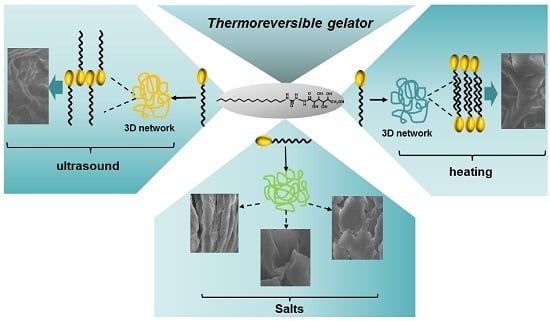Ultrasound- and Temperature-Induced Gelation of Gluconosemicarbazide Gelator in DMSO and Water Mixtures
Abstract
:1. Introduction
2. Results and Discussion
2.1. Fourier transform infrared spectroscopy (FT-IR)
2.2. Thermal Properties
2.3. Morphology
2.4. Rheological Properties
2.5. Mode of Packing in the Xerogels
3. Conclusions
4. Experimental
4.1. Materials
4.2. Synthesis of Gluconohydrazide
4.3. Preparation of Alkyl Isocyanate from Alkyl Acyl Azide
4.4. Synthesis of Amphiphilic Glucono Semicarbazide Gelator
4.5. Gelation Tests
4.6. Instrumentation
4.6.1. Proton NMR
4.6.2. FT-IR Spectroscopy
4.6.3. Differential Scanning Calorimetry
4.6.4. X-ray Diffraction
4.6.5. Scanning Electron Microscopy (SEM)
4.6.6. Oscillatory Rheological Measurements
Supplementary Materials
Acknowledgments
Author Contributions
Conflicts of Interest
References
- Vemula, P.K.; John, G. Crops: A green approach toward self-assembled soft materials. Acc. Chem. Res. 2008, 41, 769–782. [Google Scholar] [CrossRef] [PubMed]
- John, G.; Vemula, P.K. Design and development of soft nanomaterials from biobased amphiphiles. Soft Matter. 2006, 2, 909–914. [Google Scholar] [CrossRef]
- Wang, W.; Wang, H.; Ren, C.; Wang, J.; Tan, M.; Shen, J.; Yang, Z.; Wang, P.G.; Wang, L. A saccharide-based supramolecular hydrogel for cell culture. Carbohydr. Res. 2011, 346, 1013–1017. [Google Scholar] [CrossRef] [PubMed]
- Vemula, P.K.; Wiradharma, N.; Ankrum, J.A.; Miranda, O.R.; John, G.; Karp, J.M. Prodrugs as self-assembled hydrogels: A new paradigm for biomaterials. Curr. Opin. Biotechnol. 2013, 24, 1174–1182. [Google Scholar] [CrossRef] [PubMed]
- Bühler, G.; Feiters, M.C.; Nolte, R.J.; Dötz, K.H. A metal–carbene carbohydrate amphiphile as a low-molecular-mass organometallic gelator. Angew. Chem. Int. Ed. 2003, 42, 2494–2497. [Google Scholar] [CrossRef] [PubMed]
- Nandi, S.; Altenbach, H.J.; Jakob, B.; Lange, K.; Ihizane, R.; Schneider, M.P.; Gün, U.; Mayer, A. Amphiphiles based on d-glucose: Efficient low molecular weight gelators. Org. Lett. 2012, 14, 3826–3829. [Google Scholar] [CrossRef] [PubMed]
- Latxague, L.; Gaubert, A.; Maleville, D.; Baillet, J.; Ramin, M.A.; Barthélémy, P. Carbamate-based bolaamphiphile as low-molecular-weight hydrogelators. Gels 2016, 2, 25. [Google Scholar] [CrossRef]
- Fuhrhop, J.H.; Helfrich, W. Fluid and solid fibers made of lipid molecular bilayers. Chem. Rev. 1993, 93, 1565–1582. [Google Scholar] [CrossRef]
- Jung, J.H.; Rim, J.A.; Han, W.S.; Lee, S.J.; Lee, Y.J.; Cho, E.J.; Kim, J.S.; Ji, Q.; Shimizu, T. Hydrogel behavior of a sugar-based gelator by introduction of an unsaturated moiety as a hydrophobic group. Org. Biomol. Chem. 2006, 4, 2033–2038. [Google Scholar] [CrossRef] [PubMed]
- Mathiselvam, M.; Loganathan, D.; Varghese, B. Synthesis and characterization of thiourea-and urea-linked glycolipids as low-molecular-weight hydrogelators. RSC Adv. 2013, 3, 14528–14542. [Google Scholar] [CrossRef]
- Goyal, N.; Cheuk, S.; Wang, G. Synthesis and characterization of d-glucosamine-derived low molecular weight gelators. Tetrahedron 2010, 66, 5962–5971. [Google Scholar] [CrossRef]
- Sankarprasad, B.; Hyean Kim, B. An insulin-sensing sugar-based fluorescent hydrogel. Chem. Commun. 2006, 17, 1842–1844. [Google Scholar]
- Wang, G.; Cheuk, S.; Yang, H.; Goyal, N.; Reddy, P.N.; Hopkinson, B. Synthesis and characterization of monosaccharide-derived carbamates as low-molecular-weight gelators. Langmuir 2009, 25, 8696–8705. [Google Scholar] [CrossRef] [PubMed]
- Hafkamp, R.J.; Feiters, M.C.; Nolte, R.J. Organogels from carbohydrate amphiphiles. J. Org. Chem. 1999, 64, 412–426. [Google Scholar] [CrossRef]
- Jung, J.H.; John, G.; Masuda, M.; Yoshida, K.; Shinkai, S.; Shimizu, T. Self-assembly of a sugar-based gelator in water: Its remarkable diversity in gelation ability and aggregate structure. Langmuir 2001, 17, 7229–7232. [Google Scholar] [CrossRef]
- Ohsedo, Y.; Oono, M.; Saruhashi, K.; Watanabe, H. N-Alkylamido-d-glucamine-based gelators for the generation of thixotropic gels. RSC Adv. 2014, 4, 48554–48558. [Google Scholar] [CrossRef]
- Jung, J.H.; Shinkai, S.; Shimizu, T. Spectral Characterization of self-assemblies of aldopyranoside amphiphilic gelators: What is the essential structural difference between simple amphiphiles and bolaamphiphiles? Chem. Eur. J. 2002, 8, 2684–2690. [Google Scholar] [CrossRef]
- Yan, N.; He, G.; Zhang, H.; Ding, L.; Fang, Y. Glucose-based fluorescent low-molecular mass compounds: Creation of simple and versatile supramolecular gelators. Langmuir 2009, 26, 5909–5917. [Google Scholar] [CrossRef] [PubMed]
- Clemente, M.J.; Romero, P.; Serrano, J.L.; Fitremann, J.; Oriol, L. Supramolecular hydrogels based on glycoamphiphiles: Effect of the disaccharide polar head. Chem. Mater. 2012, 24, 3847–3858. [Google Scholar] [CrossRef]
- Minakuchi, N.; Hoe, K.; Yamaki, D.; Ten-no, S.; Nakashima, K.; Goto, M.; Mizuhata, M.; Maruyama, T. Versatile supramolecular gelators that can harden water, organic solvents and ionic liquids. Langmuir 2012, 28, 9259–9266. [Google Scholar] [CrossRef] [PubMed]
- Avalos, M.; Babiano, R.; Cintas, P.; Gómez-Carretero, A.; Jimenez, J.L.; Lozano, M.; Ortiz, A.L.; Palacios, J.C.; Pinazo, A. A family of hydrogels based on ureido-linked aminopolyol-derived amphiphiles and bolaamphiphiles: Synthesis, gelation under thermal and sonochemical stimuli, and mesomorphic characterization. Chem. Eur. J. 2008, 14, 5656–5669. [Google Scholar] [CrossRef] [PubMed]
- Cui, J.; Liu, A.; Guan, Y.; Zheng, J.; Shen, Z.; Wan, X. Tuning the helicity of self-assembled structure of a sugar-based organogelator by the proper choice of cooling rate. Langmuir 2009, 26, 3615–3622. [Google Scholar] [CrossRef] [PubMed]
- Zhou, S.L.; Matsumoto, S.; Tian, H.D.; Yamane, H.; Ojida, A.; Kiyonaka, S.; Hamachi, I. pH-responsive shrinkage/swelling of a supramolecular hydrogel composed of two small amphiphilic molecules. Chem. Eur. J. 2005, 11, 1130–1136. [Google Scholar] [CrossRef] [PubMed]
- Clemente, M.J.; Tejedor, R.M.; Romero, P.; Fitremann, J.; Oriol, L. Maltose-based gelators having azobenzene as light-sensitive unit. RSC Adv. 2012, 2, 11419–11431. [Google Scholar] [CrossRef]
- Giammanco, G.E.; Sosnofsky, C.T.; Ostrowski, A.D. Light-Responsive Iron (III)–Polysaccharide Coordination Hydrogels for Controlled Delivery. ACS Appl. Mater. Interfaces 2015, 7, 3068–3076. [Google Scholar] [CrossRef] [PubMed]
- Zhang, C.; Losego, M.D.; Braun, P.V. Hydrogel-based glucose sensors: Effects of phenylboronic acid chemical structure on response. Chem. Mater. 2013, 25, 3239–3250. [Google Scholar] [CrossRef]
- Zheng, Y.; Wang, A. Ag nanoparticle-entrapped hydrogel as promising material for catalytic reduction of organic dyes. J. Mater. Chem. 2012, 22, 16552–16559. [Google Scholar] [CrossRef]
- Rapoport, N.Y.; Kennedy, A.M.; Shea, J.E.; Scaife, C.L.; Nam, K.H. Controlled and targeted tumor chemotherapy by ultrasound-activated nano emulsions/microbubbles. J. Control. Release. 2009, 138, 268–276. [Google Scholar] [CrossRef] [PubMed]
- Wu, J.; Yi, T.; Shu, T.; Yu, M.; Zhou, Z.; Xu, M.; Zhou, Y.; Zhang, H.; Han, J.; Li, F.; et al. Ultrasound switch and thermal self-repair of morphology and surface wettability in a cholesterol-based self-assembly system. Angew. Chem. 2008, 120, 1079–1083. [Google Scholar] [CrossRef]
- Zhang, Y.; Ding, H.; Wu, Y.; Zhang, C.; Bai, B.; Wang, H.; Li, M. Ultrasound-induced controllable morphology and growth dimension in a dihydrazide-based self-assembly system. Soft Matter. 2014, 10, 8838–8845. [Google Scholar] [CrossRef] [PubMed]
- Park, S.M.; Kim, B.H. Ultrasound-triggered water gelation with a modified nucleoside. Soft Matter. 2008, 4, 1995–1997. [Google Scholar] [CrossRef]
- Wang, Y.; Zhan, C.; Fu, H.; Li, X.; Sheng, X.; Zhao, Y.; Xiao, D.; Ma, Y.; Ma, J.S.; Yao, J. Switch from intra-to intermolecular H-bonds by ultrasound: Induced gelation and distinct nanoscale morphologies. Langmuir 2008, 24, 7635–7638. [Google Scholar] [CrossRef] [PubMed]
- Xu, J.; Wang, Y.; Shan, H.; Lin, Y.; Chen, Q.; Roy, V.A.; Xu, Z. Ultrasound-induced organogel formation followed by thin film fabrication via simple doctor blading technique for field-effect transistor applications. ACS Appl. Mater. Interfaces 2016, 8, 18991–18997. [Google Scholar] [CrossRef] [PubMed]
- Dou, C.; Wang, C.; Zhang, H.; Gao, H.; Wang, Y. Novel urea-functionalized quinacridone derivatives: Ultrasound and thermo effects on supramolecular organogels. Chem. Eur. J. 2010, 16, 10744–10751. [Google Scholar] [CrossRef] [PubMed]
- Goyal, N.; Mangunuru, H.P.; Parikh, B.; Shrestha, S.; Wang, G. Synthesis and characterization of pH responsive d-glucosamine based molecular gelators. Beilstein J. Org. Chem. 2014, 10, 3111–3121. [Google Scholar] [CrossRef] [PubMed]
- Srivastava, A.; Ghorai, S.; Bhattacharjya, A.; Bhattacharya, S. A tetrameric sugar-based azobenzene that gels water at various pH values and in the presence of salts. J. Org. Chem. 2005, 70, 6574–6582. [Google Scholar] [CrossRef] [PubMed]
- Pal, A.; Shrivastava, S.; Dey, J. Salt, pH and thermoresponsive supramolecular hydrogel of N-(4-N-tetradecyloxybenzoyl)-l-carnosine. Chem. Commun. 2009, 45, 6997–6999. [Google Scholar] [CrossRef] [PubMed]
- Grillo, I.; Kats, E.I.; Muratov, A.R. Formation and growth of anionic vesicles followed by small-angle neutron scattering. Langmuir 2003, 19, 4573–4581. [Google Scholar] [CrossRef]
- Zhai, L.; Zhao, M.; Sun, D.; Hao, J.; Zhan g, L. Salt-induced vesicle formation from single anionic surfactant SDBS and its mixture with LSB in aqueous solution. J. Phys. Chem. B 2005, 109, 5627–5630. [Google Scholar] [CrossRef] [PubMed]
- Baddi, S.; Madugula, S.S.; Sarma, D.S.; Soujanya, Y.; Palanisamy, A. Combined Experimental and computational study of the gelation of cyclohexane-based bis(acyl-semicarbazides) and the multi-stimuli-responsive properties of their gels. Langmuir 2016, 32, 889–899. [Google Scholar] [CrossRef] [PubMed]
- Das Mahapatra, R.; Dey, J. Ultrasound-induced gelation of organic liquids by l-cysteine-derived amphiphile containing poly(ethylene glycol) tail. Langmuir 2015, 31, 8703–8709. [Google Scholar] [CrossRef] [PubMed]
- Moniruzzaman, M.; Sundararajan, P.R. Low molecular weight organogels based on long-chain carbamates. Langmuir 2005, 21, 3802–3807. [Google Scholar] [CrossRef] [PubMed]
- Vemula, P.K.; Aslam, U.; Mallia, V.A.; John, G. In situ synthesis of gold nanoparticles using molecular gels and liquid crystals from vitamin-C amphiphiles. Chem. Mater. 2007, 19, 138–140. [Google Scholar] [CrossRef]
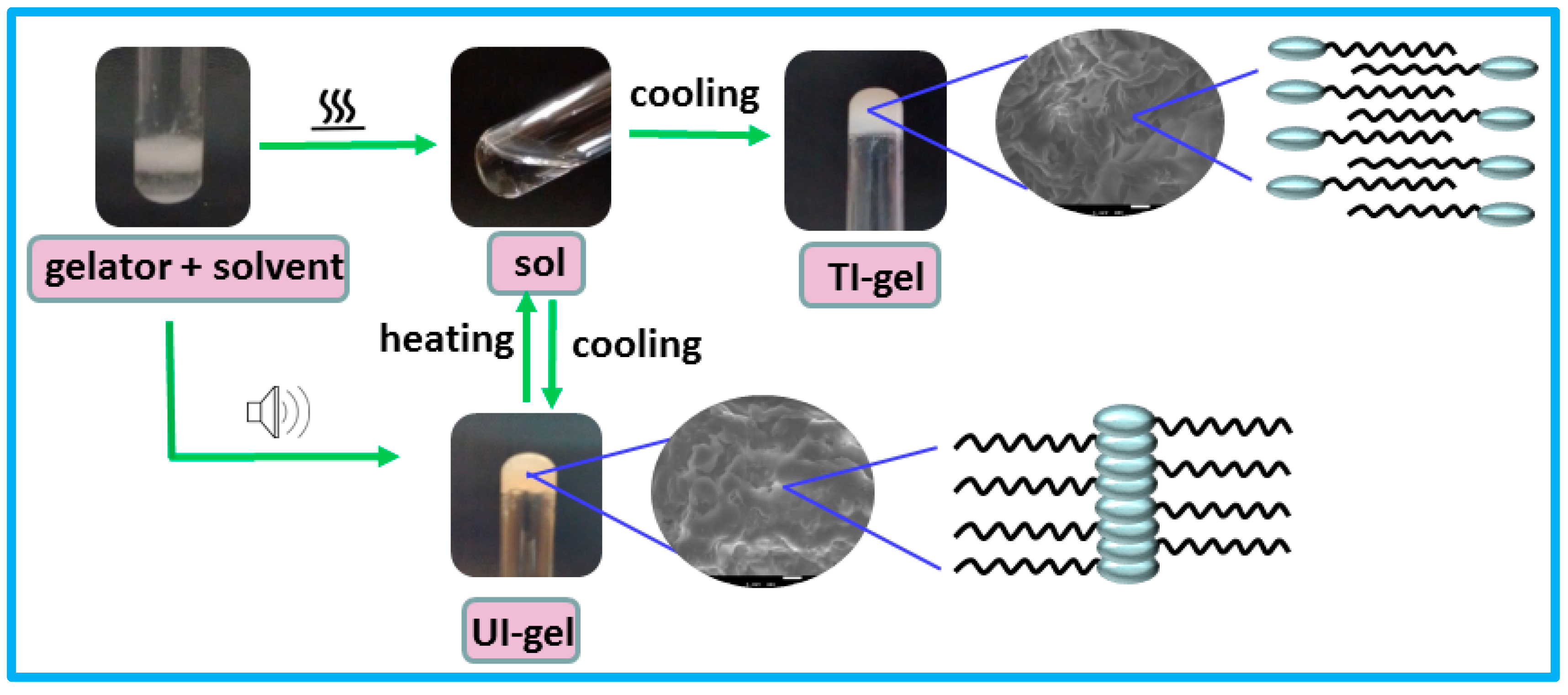
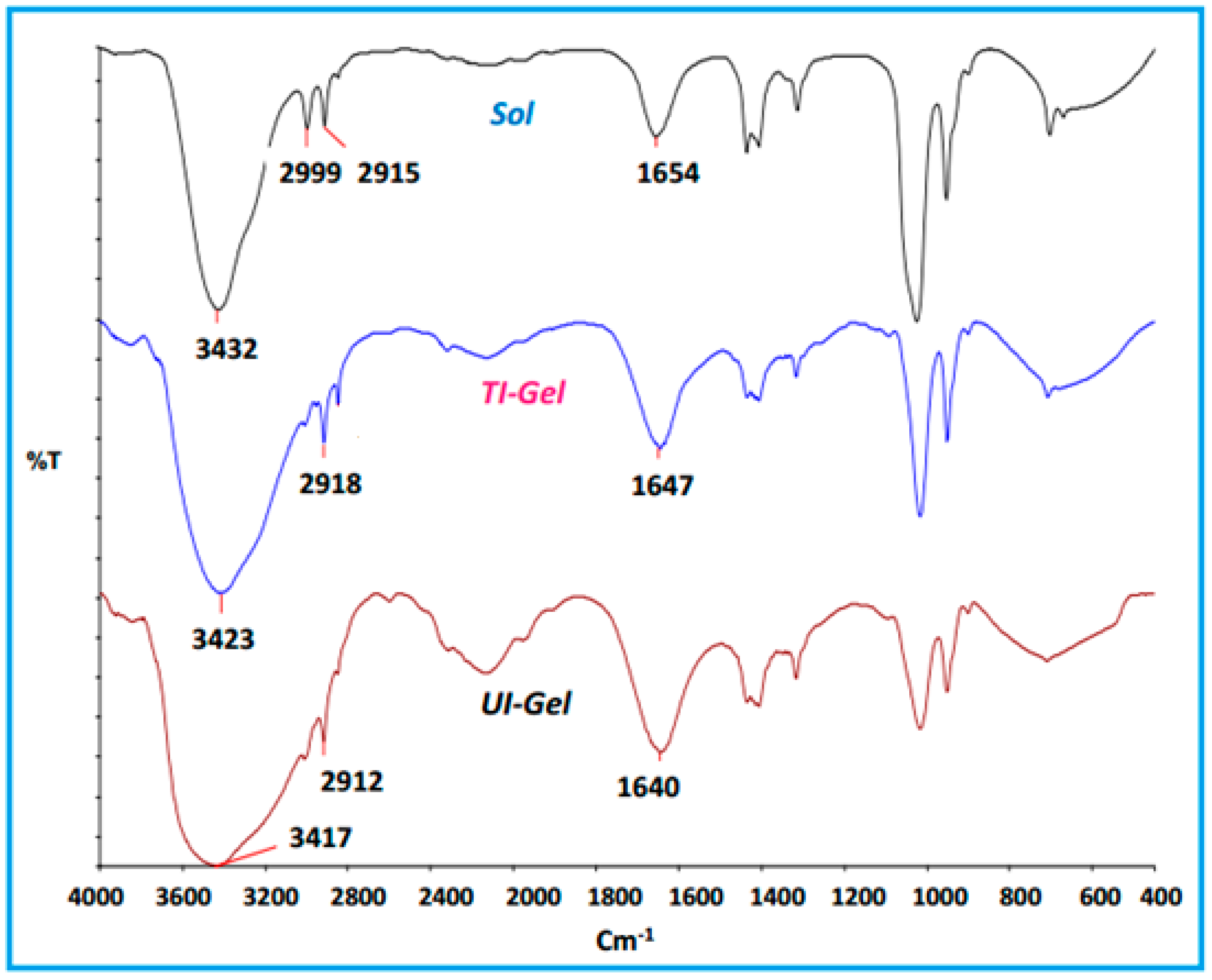
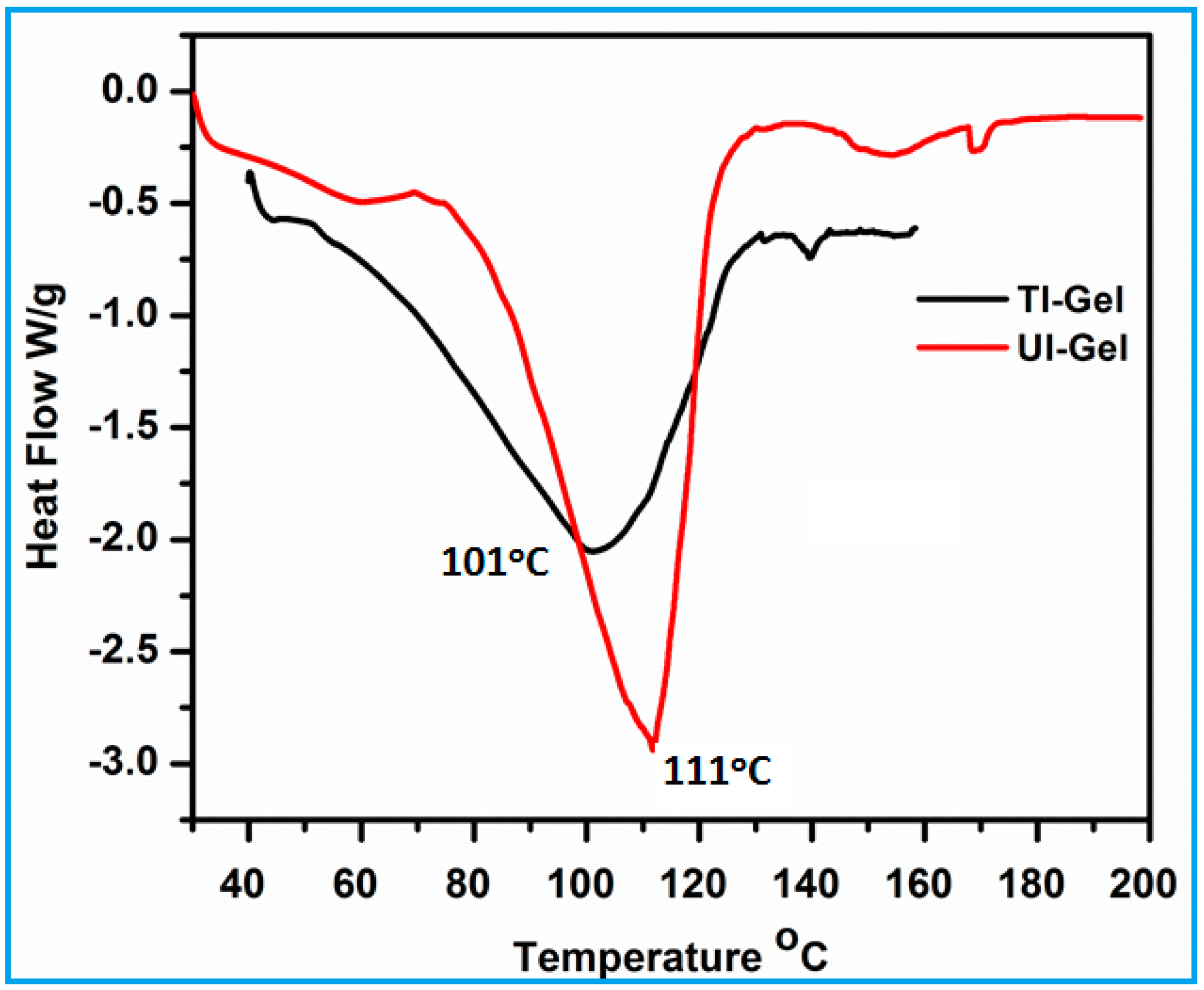

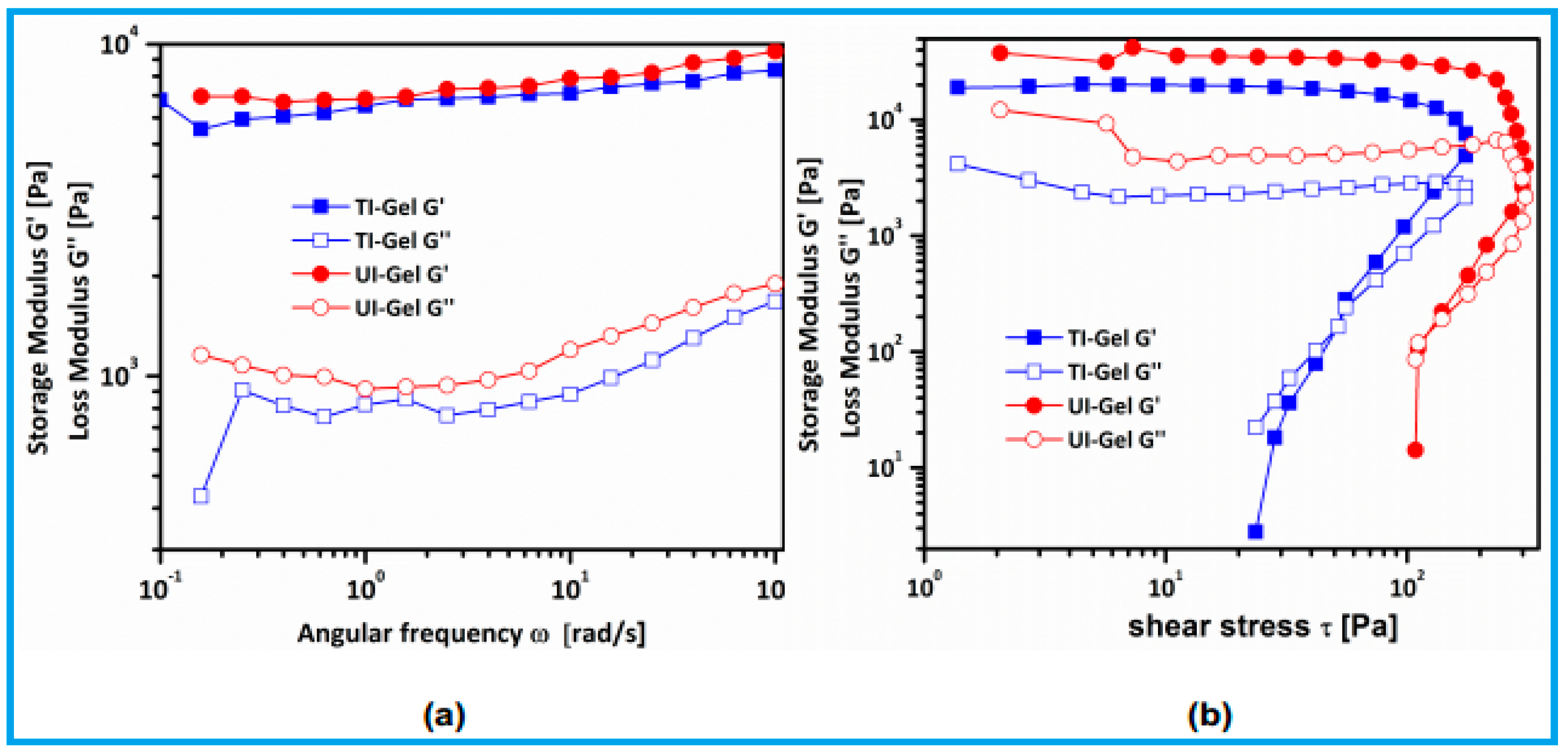

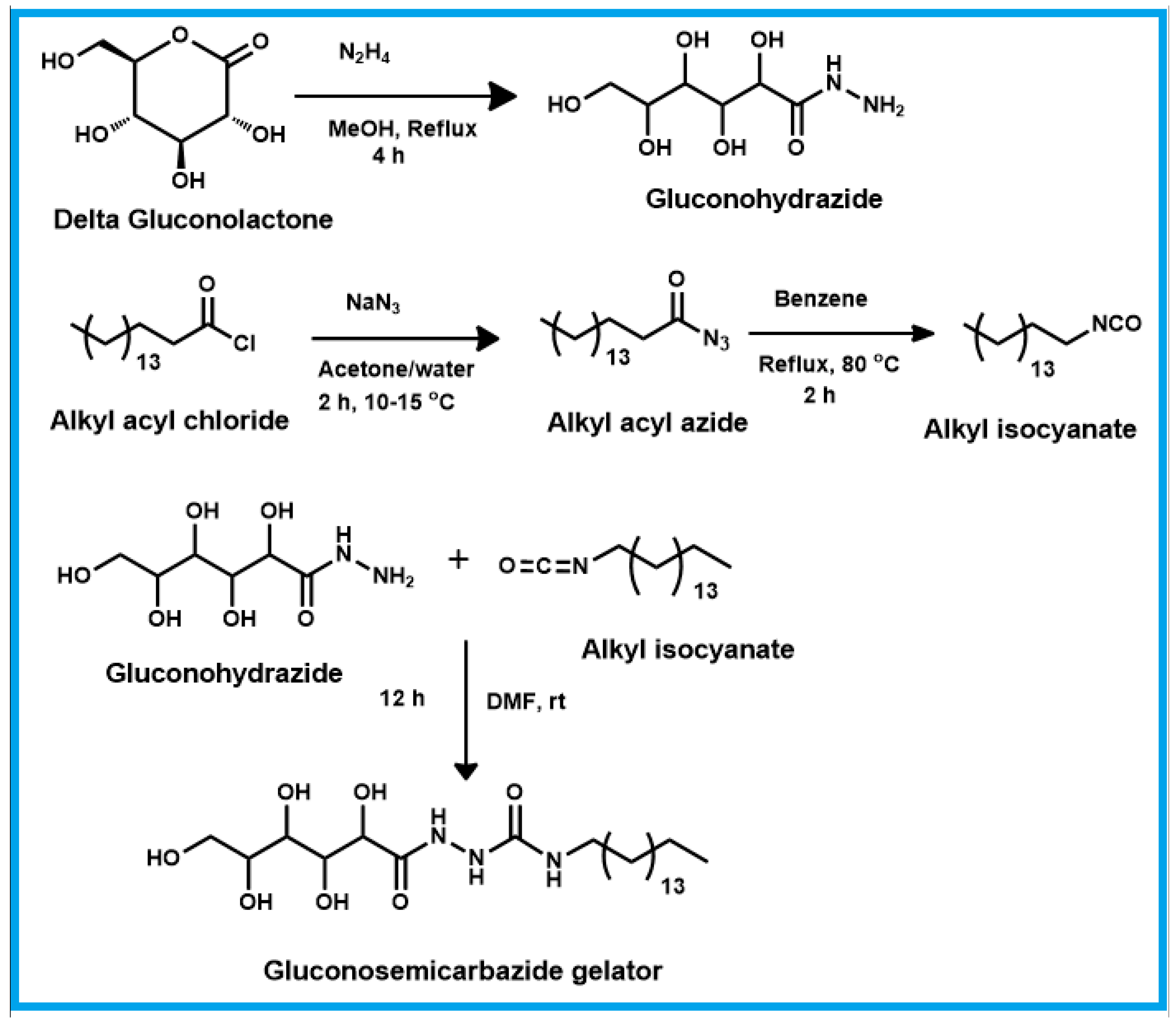
© 2017 by the authors. Licensee MDPI, Basel, Switzerland. This article is an open access article distributed under the terms and conditions of the Creative Commons Attribution (CC BY) license (http://creativecommons.org/licenses/by/4.0/).
Share and Cite
Himabindu, M.; Palanisamy, A. Ultrasound- and Temperature-Induced Gelation of Gluconosemicarbazide Gelator in DMSO and Water Mixtures. Gels 2017, 3, 12. https://doi.org/10.3390/gels3020012
Himabindu M, Palanisamy A. Ultrasound- and Temperature-Induced Gelation of Gluconosemicarbazide Gelator in DMSO and Water Mixtures. Gels. 2017; 3(2):12. https://doi.org/10.3390/gels3020012
Chicago/Turabian StyleHimabindu, Mothukunta, and Aruna Palanisamy. 2017. "Ultrasound- and Temperature-Induced Gelation of Gluconosemicarbazide Gelator in DMSO and Water Mixtures" Gels 3, no. 2: 12. https://doi.org/10.3390/gels3020012




